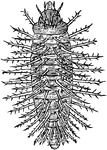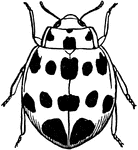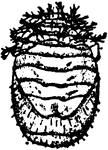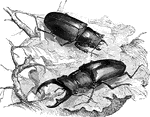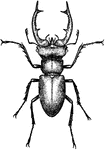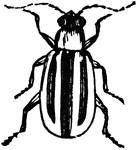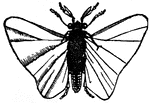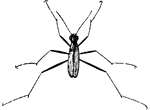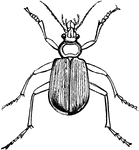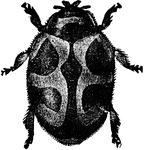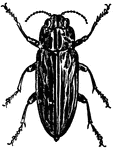This ClipArt gallery includes 561 illustrations of insects from the order Coleoptera, including beetles, weevils, borers, carabus, scarabs, and ladybugs (also known as ladybirds or lady beetles).
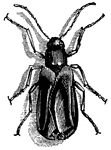
Sitaris Humeralis
"The female Sitaris Humeralis lays at the entrance of the nest of a solitary bee from 2,000…

First Larva of Sitaris Humeralis
"A month afterward there come out of these eggs very small larvae, of a shining dark green, hard-skinned,…

Pseudo Nymph of Sitaris Humeralis
"When the male bees have built the cells and furnished them with honey, the female, as we know, deposits…

Pupa of Sitaris Humeralis
The second larva stage lasts for 6 weeks. It contracts and passes through the winter. "In the spring…

Third Larva of Sitaris Humeralis
The second larva stage lasts for 6 weeks. It contracts and passes through the winter. "In the spring…

Spruce Beetle
"Galleries of the spruce-destroying beetle beneath the bark of a spruce tree." —Davison, 1906
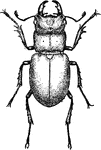
Stag Beetle
Lucanus Dama, the most common stag beetle in which the mandibles of the male are much enlarged and sickle-shaped;…

Stag Beetle (Lucanus Cervus)
"They live in half rotten trees. Their strength enables them to lift considerable wieghts. They do not…
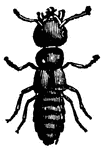
Imago of Staphylinus (Ocypus) Olens
"This specimen lives in the carcasses of animals, on manure, and attacks living insects. It is a carnivorous,…

Larva of Staphylinus (Ocypus) Olens
"This specimen lives in the carcasses of animals, on manure, and attacks living insects. It is a carnivorous,…

Subangular Ground Beetle
"Subangular Ground-beetle (Aspidoglossa subangulata). Vertical line shows natural size."-Whitney, 1902
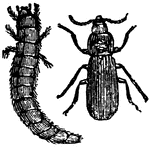
Tenebrio Molitor (Larva and Imago)
"A blackish-brown insect. The larvae are the well-known meal-worms, which live in flour."

Tiger Beetles
Beetles form a large group of insects that number over 300,000 species. They all have hard wings which…

Tiger Beetle
"Its distinguishing features are its small eyes, separate posterior coxae, and widely inflexed margin…

Tiger Beetle
A beetle with a contignous posterior coxae, large prominent eyes, ad maxillary palpi with the third…
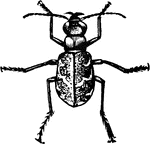
Tiger Beetle
A beetle with a contignous posterior coxae, large prominent eyes, ad maxillary palpi with the third…

Tiger Beetle
A beetle with a contignous posterior coxae, large prominent eyes, ad maxillary palpi with the third…

Tiger Beetle
A beetle with a contignous posterior coxae, large prominent eyes, ad maxillary palpi with the third…

Tiger Beetle
The tiger beetles are a large group of beetles known for their predatory habits. Some tiger beetles…

Tiger Beetle (Cicindela Heros)
"Their ferocity is remarkable. They quickly tear off the wings and legs of their victim, and suck out…

Under Side of Pupa of Tiger Beetle (Cicindela Heros)
"Their ferocity is remarkable. They quickly tear off the wings and legs of their victim, and suck out…
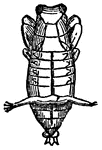
Upper Side of Pupa of Tiger Beetle (Cicindela Heros)
"Their ferocity is remarkable. They quickly tear off the wings and legs of their victim, and suck out…
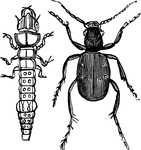
Tiger Beetle and Larvae
"The common European species, Cincindela campestris, may be found flying and running around…
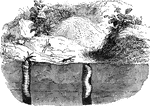
Tiger Beetle Larve
"The common European species, Cincindela campestris, may be found flying and running around…

Typograhic Beetle
"The typographic beetle recieves it's name... from the circumstance that the burrows formed by it in…
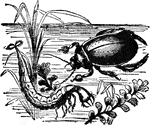
Water Beetle
"Water Beetles are beetles which live on or in the water. The Dytiscus, common in stagnant water, is…
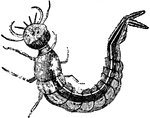
Water Beetle Larva
Water beetles carry air bubbles under their abdomens, which provides an air supply. Water beetle larvae…

Whirligig Beetle Larva
The whirligig beetles are a family (Gyrinidae) of water beetles that normally live on the surface of…

Wood Tiger Beetle
A group of beetles known for being preditors. They have bulging eyes and slender legs.

Metallic Wood-Boring Beetle
Gyascutus planicosta is a species of Metallic Wood-Boring Beetles in the Buprestidae family.

Woodboring Beetle
The term woodboring beetle encompasses many species and families of beetles whose larval or adult forms…

Xylotrupes Dichotomus
"A common specimen about an inch long, of a chestnut brown and perfectly smooth. The male, but not the…

Burying Beetles, Burying a Dead Bird
Also called Sexton Beetles, these beetles bury the carcasses of small vertebrates as food for their…

